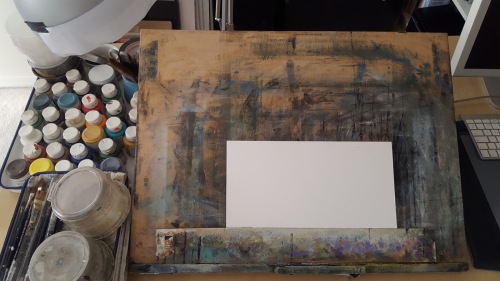Looking carefully at one of Yoko Tanaka’s images rewards you with details that on a quick perusal you could easily miss. They are feather-light, with the delicacy of a dragonfly’s wing.
I met Yoko through Rotem Moscovich, an editor at Hyperion Publishing who saw her in New York last Fall and thoughtfully introduced us to each other over e-mail. Yoko has lived in London since 2011 and Rotem knew that I had recently relocated here.
I have enjoyed talking with Yoko and learning a bit about her process and approach to imagery. She was kind enough to consent to my featuring her on this blog, and invited me to her studio.
There is an ethereal, dreamlike quality to Yoko’s illustrations. Monochromatic in tone, the elements emerge out of shadows as if lit by the moon. Since her paintings are often dark with a limited, earthy palette, she says she receives many jobs whose stories deal with “winter, snow, night, death, witches and magic, and children with problem parents.” She is excited that her next picture book project has “100% happy components.”
There is a sadness in many of the pieces, but there is humor as well. Each face tells a story. There are no abbreviations when it comes to elements that convey emotion. Emotion is a word Yoko uses frequently when talking about her work. It is the element she strives to communicate visually. She succeeds.
It surprised me to learn that Yoko first studied Law in Japan, her native country, before moving to California in 2000 to study design. She was then accepted to Art Center College in Pasadena where she changed direction to study painting, intending to become a gallery artist. Her first painting was of a large coffee cup.
She enjoys painting on a bigger scale, but that isn’t practical for reproduction, and her current studio space is small. Her illustration work is done to size or slightly larger (which is tiny for the amount of detail she includes).
It was literary agent Steve Malk who first encouraged her to pursue illustration rather than gallery work. She has been working with Steve since 2005. One of the first book contracts Steve brought to her was to illustrate Kate DiCamillo’s The Magician’s Elephant for Candlewick Press in 2008.
Four months is Yoko’s ideal amount of time for a children’s book project; one month to sketch and three months to paint. She doesn’t like projects to go on much longer than that. One project at a time is better for her than overlapping jobs.
Yoko says that ideas don’t come to her while she is sitting at her drawing table. Driving a car is where she prefers to do her thinking – in quiet isolation, following a well-known route. In London, she walks instead.
When she gets an idea, it comes to her fully formed, in 3-D, sometimes even with sounds and smells. She then sketches it with pencil and paper as quickly as possible. Revisions are relatively few. She will use Photoshop to add color and value for preliminaries to show clients, but her finished work is usually done in acrylic paints on illustration board.
Yoko recently completed a cover for a new edition of The Magician’s Elephant as part of Candlewick’s reissue of five of DiCamillo’s books in their Fall/Winter 2015 catalog. The publisher wanted a brighter palette with the animal in the center of the composition, in keeping with the rest of the paperback collection.
Yoko also showed me the art she created for the first edition of Tiny Pencil, an art-zine “devoted to the lead arts.” These illustrations are done in graphite, not her usual medium. She used stencils and chamois cloth to create the gradations of value. The images have a ghost-like quality that is both poignant and spooky.
I am grateful to Yoko for taking the time to welcome me to her studio, and for sharing her ideas and process, as well as her time. I look forward to seeing more of her work in the future, perhaps on a gallery wall as well as in books.
































